Read the Report
Home / Read the Report
Appendix 12: Training about Child Sexual Abuse Prevention
Educating Children and Youth
All children and youth need to receive education about preventing abuse, neglect, bullying and harassment. This education is best adapted to an age-appropriate level to promote their understanding of, and confidence in the organization’s strategies to keep them safe. However, not all YSOs will be capable of providing prevention training to the children/youth who attend their programs or utilize their services. In these cases, codes of conduct, mission statements, handouts on rules and regulations, orientation meetings, and other means of communication can be used to define for children and youth the elements of being safe. If it is within the scope of the YSO’s responsibilities, children and youth should be provided an understanding of:
- Their right to be safe and cared for.
- Basic, age-appropriate information about emotional, physical, sexual abuse and neglect, bullying and harassment.
- Prevention strategies to help keep them safe in their home, family, community, and on the Internet.
- Where and how to report abuse, bullying and harassment.
- How to help a friend who is being abused, bullied or harassed.
- The characteristics of healthy versus unsafe relationships.
- Violence prevention in dating and relationships.
- How organizations have a responsibility to keep youth safe and must report abuse (mandated reporting).
Critical Content for Training Children and Youth
- Child sexual abuse information
- This information may be provided through partnerships with local schools or other organizations already providing CSA prevention training for youth.
- Provide general information about child sexual abuse, including what constitutes appropriate, inappropriate, and harmful behavior from adults and other youth.
- Youth need to know that no one, including other youth, has the right to force, trick, or coerce them or other children/youth into sexual situations and that sexual offenders, not their victims, are responsible for their behavior
- Teach youth how to interact appropriately with each other. Discuss the importance of reporting sexual abuse
- Tell youth who they should report to when they experience or observe behaviors they believe are inappropriate or harmful
- Seek assistance from other organizations that have created personal safety programs if your organization is interested in implementing one
The chart below identifies some of the grade-appropriate learning standards and lesson objectives gathered from several sources.
| Learning Standards | Lesson Objectives | |
| Grades K-3 | – List rules for safety at home, school, community. – Distinguish among safe, unsafe, and inappropriate touch. – Demonstrate the use of assertive behavior, refusal skills, and actions intended for personal safety. | – Identify general safety rules. – Identify the “always ask first rule.” – Identify safe and unsafe touches. – Identify the “touching rule.” – Identify and practice rules for personal safety: say no, get away, tell a grown-up. – Identify grown-ups you can go to for help. |
| Grades 4-6 | – Describe actions & behaviors to protect oneself when alone at home or in the community. – Distinguish among safe, unsafe, & inappropriate touch. – Demonstrate the use of assertive behavior, refusal skills, and actions intended for personal safety. | – Identify and practice safety rules when alone at home or in the community. – Summarize the difference between appropriate & inappropriate touch. – Describe what to do to protect oneself in situations involving unwanted or inappropriate touch. – Identify and practice skills for standing up to pressure from other people. – Summarize ways to respond to sexual abuse. – Identify appropriate sources for help. |
| Grades 7-9 | – Distinguish between healthy & unhealthy interpersonal relationships. – Define sexual harassment in the context of schools and other youth settings. – Recognize sexual abuse and sexual assault. – Describe actions & behaviors to protect oneself from sexual abuse and how to seek help. | – Examine the potential impact of healthy & harmful relationships. – Identify personal boundaries & practice communicating boundaries to others. – Identify & practice skills for dealing with both physical and online sexual harassment. – Identify the warning signs of potential danger in relationships. Identify ways to stay out of danger in relationships. – Identify where help can be located. |
| Grades 10-12 | – Define sexual assault terms and refamiliarize students with the general topic of sexual abuse. – Demonstrate prevention skills in a variety of scenarios and circumstances. – Understand the personal and community resources available if one is harassed or victimized. | – Define and contrast aggressive, passive, and assertive behaviors. – Explain acquaintance rape, sexual assault, incest and trafficking as forms of child sexual abuse. – Understand laws regarding types of abuse and reporting guidelines. – Specify personal and local community resources for victims of sexual abuse. – List and explain several prevention guidelines. – Summarize facts on offenders, victims, and ways victims get trapped. – Classify options for victims to extricate themselves from the abusive environment. |
Elements to Consider when Identifying Potential Training Curricula for Children and Youth
- Research – Child Personal Safety Instruction
- Programs are successful when they are based on the most current research in prevention education
- Are rigorously evaluated
- Begin as early as pre-Kindergarten
- Use developmentally sequenced materials
- Utilize active, systematic and specific skills training
- Have multiple program components such as classroom training combined with parental involvement
- Use interactive instructional techniques that provide children multiple opportunities to observe the desired behavior
- Model the behavior and get feedback
- Are instituted as a comprehensive part of the child’s education – repeated many times during the school year
- Instituted over several years of instruction
- What Does the Research Say about Child Personal Safety Instruction?
- Majority of studies do not support contention that personal safety instruction produces fear and anxiety about safety issues in children participating in programs
- Children’s appropriate-touch recognition scores did not decrease significantly
- Finkelhor and Dziuba-Leatherman Study, 1995 1 : Found that some respondents reported that exposure to personal safety training resulted in more worry about abuse and more fear of adults, however, children with increased worry and fear were also children who along with their parents, reported having the most positive feelings about programs and the greatest utilization of skills
- Casper Study, 1999 2 : looked at characteristics of children with positive or negative reactions to a prevention program. One finding of the study: children who are generally more anxious and who feel that they have no control over what happens to them –especially girls – are more likely to become afraid of being touched inappropriately. Study recommended careful preparation and debriefing for these children to alleviate anxiety aroused by the program
- Involving Parents
- Most successful prevention programs actively engage parents
- Organizations should be encouraged to select curricula that include training materials for parents through information/education evenings, take-home papers and take-home family exercise sheets.
- Developmentally Sequenced Curriculum
- Programs for younger students tend to be more rules-based (If someone tries to touch you in an inappropriate way, say “No”, get away, tell a grown-up)
- Programs for older students contextualize the personal safety training within experiences appropriate to their developmental stage (being out of the house, being with groups, dating, babysitting, etc.).
- Checklist for Choosing Child Personal Safety Curricula
- Includes skills building along with instruction
- Strengthens child’s/youth’s self-confidence and self-esteem
- Develops knowledge of basic safety skills
- Distinguishes between appropriate and inappropriate touch
- Instructs children/youth to be able to say “no” to unwanted overtures
- Teaches children/youth self-protective skills
- Encourages disclosure by instructing children and youth to always tell an adult about inappropriate or unwanted behaviors
- Instructs children/youth how to identify the private parts of their bodies using correct anatomical terms if appropriate for the community
- Instructs children/youth how to identify an adult they can trust; the importance of talking to an adult if something bothers them and that some secrets need to be told
- Instructs children/youth that adults sometime act inappropriately
- Emphasizes the fact that inappropriate adult behavior is never the fault of the child or youth
- Teaches children/youth that victims can be people of any age, size, color or sex
- Teaches children/youth that adults of any age, size, color, or sex, and either strangers or people they know can have touching problems
- Teaches children and youth that other children/youth can sometimes be confused about what safe and unsafe touching are and can also have touching problems
- Presentation
- Grounded in theory and research
- Localizes curriculum to fit specific community needs
- Includes proper training for presenters, teachers, parents and community officials
- Program and materials respect the developmental abilities and limitations of children at various ages
- Includes training for developmentally and physically challenged children
- Incorporates demonstrations and rehearsal of desired behavior of each child
- Occurs on multiple occasions over several years and includes periodic reviews
- Includes supplemental sessions to reinforce skills
- Is interactive
- Includes homework
- Includes comprehensive evaluation
- Includes parental involvement
- Provides complete and accurate information about sex to older children, if appropriate for the community
- Awareness
- Fosters improved communication between a parent and a child about personal safety
- Fosters in children/youth the importance about adult supervision in their safety
- Requires the proper reporting of all child sexual or physical abuse
- Encourages parental or community involvement
- Promotes notification by responsible adults to the proper authorities of any perceived changes in a child’s behavior after instruction
- Fosters the idea that children have the right to control what happens to their bodies and to protect themselves
Resources and reports that identify abuse prevention curricula that have been evaluated for effectiveness.
- CDC list of sexual violence prevention strategies: (https://www.cdc.gov/violenceprevention/sexualviolence/prevention.html)
- National Sexual Violence Resource Center (NSVRC) document Child Sexual Abuse Prevention: Programs for Children: (http://www.nsvrc.org/sites/default/files/Publications_NSVRC_Guide_Child-Sexual-Abuse-Prevention-programs-for-children.pdf)
- NSVRC document Preventing Child Sexual Abuse – A National Resource Directory and Handbook: (http://www.nsvrc.org/sites/default/files/Publications_NSVRC_Directories_A-National-Resource-Directory-Handbook-Preventing-Child-Sexual-Abuse.pdf)
- NSVRC document Child Sexual Abuse Prevention: Programs for Adults: (http://www.nsvrc.org/publications/child-sexual-abuse-prevention-programs-adults)
- CDC Sexual Violence Prevention Technical Package: (https://www.cdc.gov/violenceprevention/pdf/sv-prevention-technical-package.pdf)
KIRKPATRICK’S FOUR LEVELS OF TRAINING EVALUATION IN DETAIL
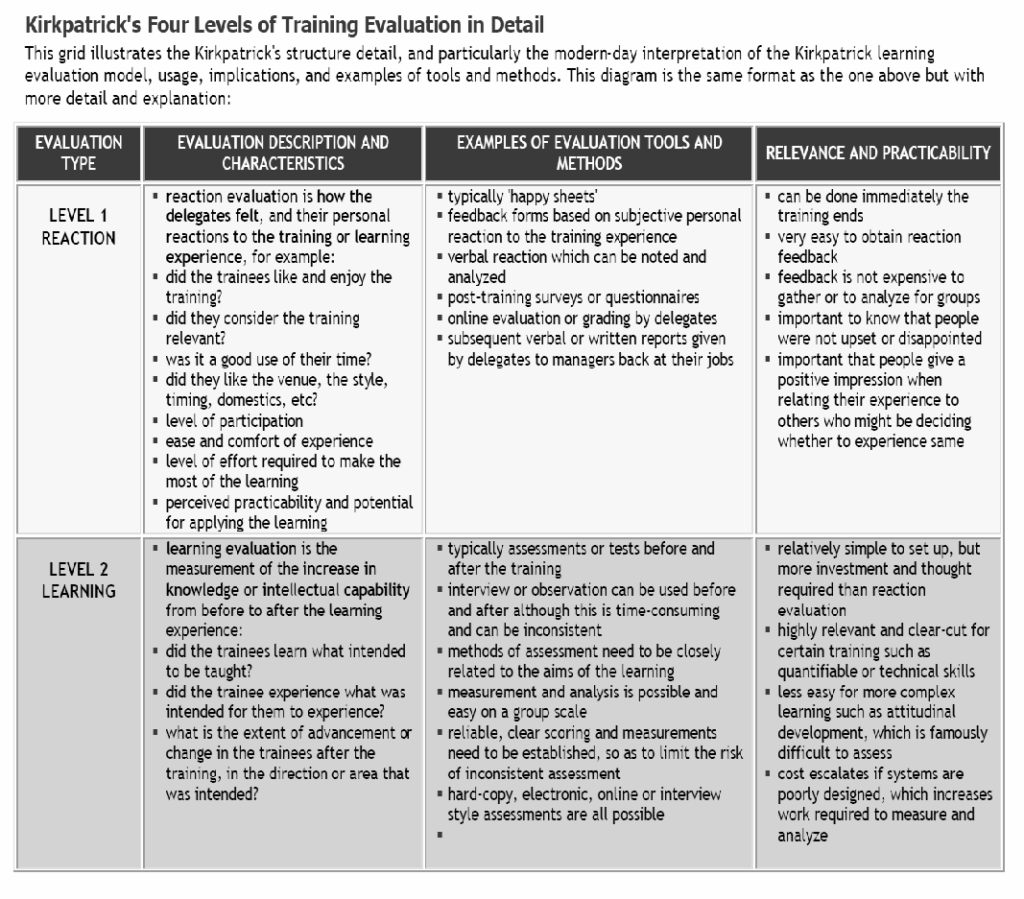
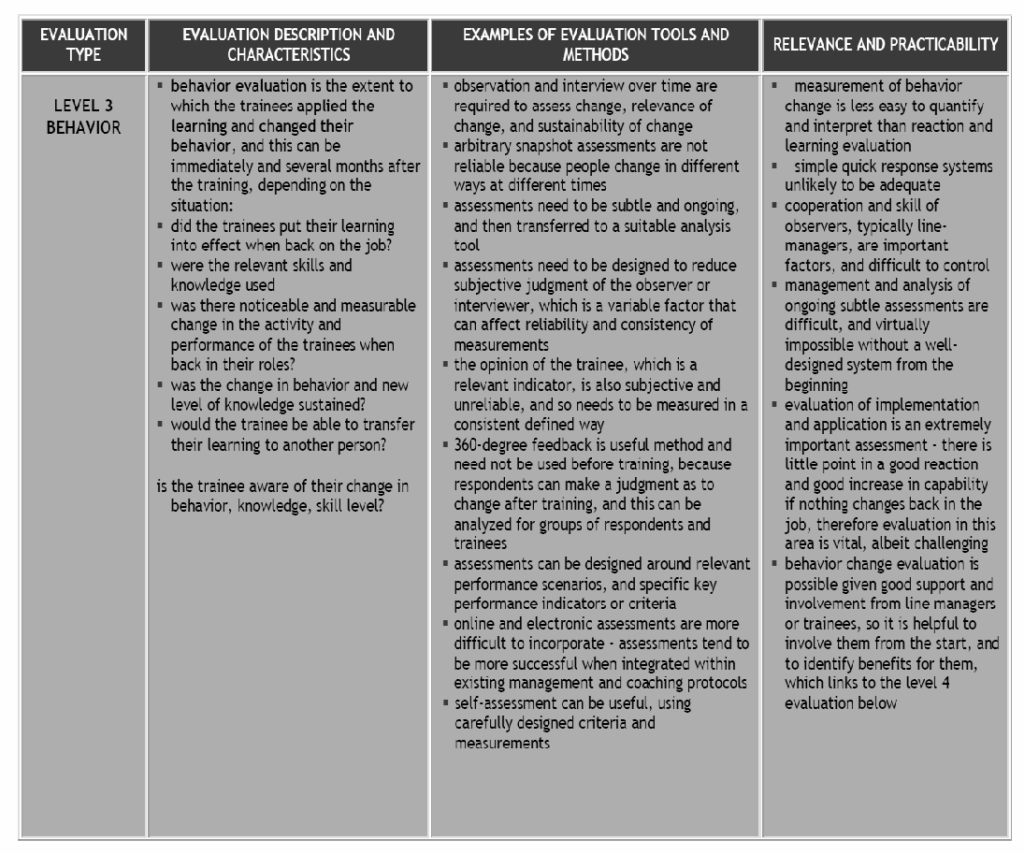

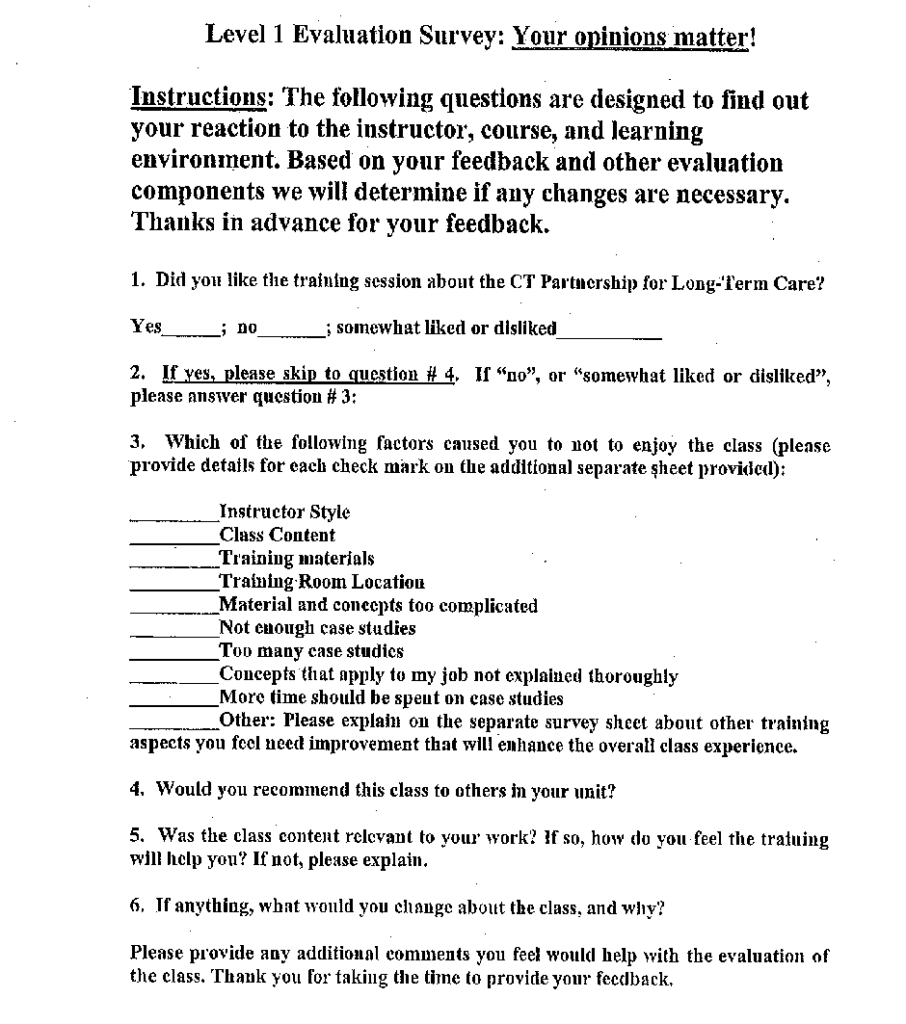
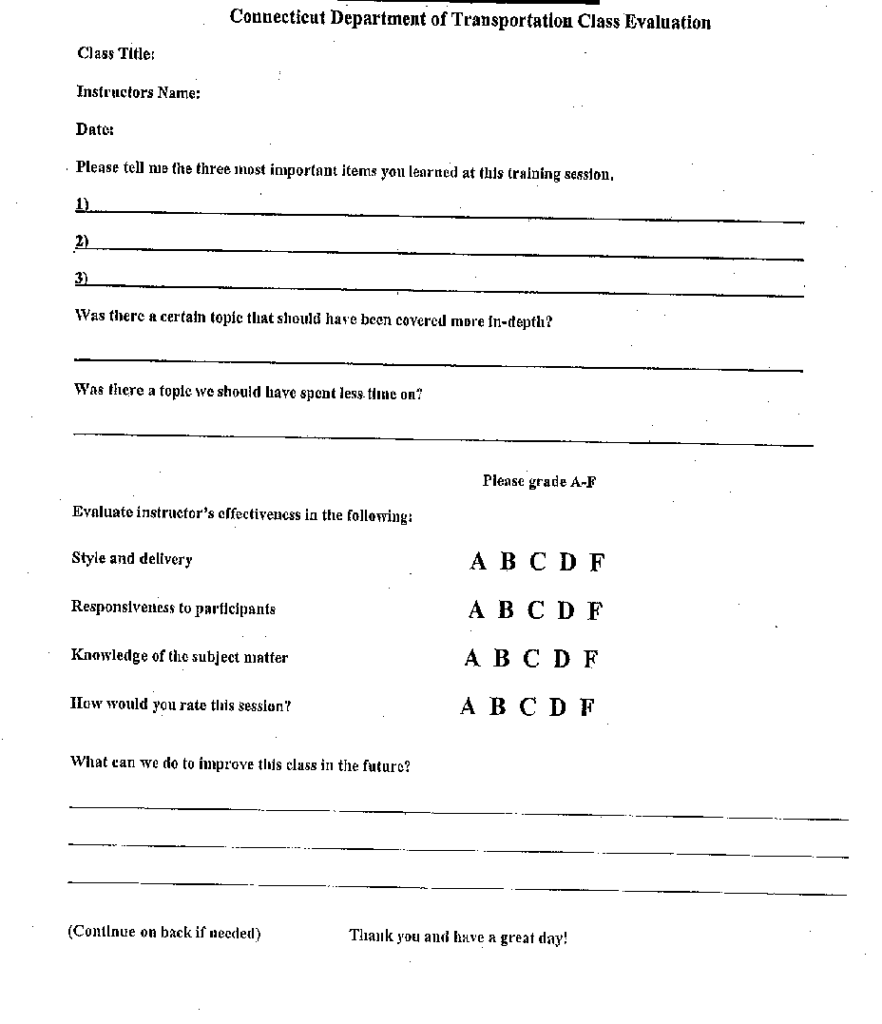
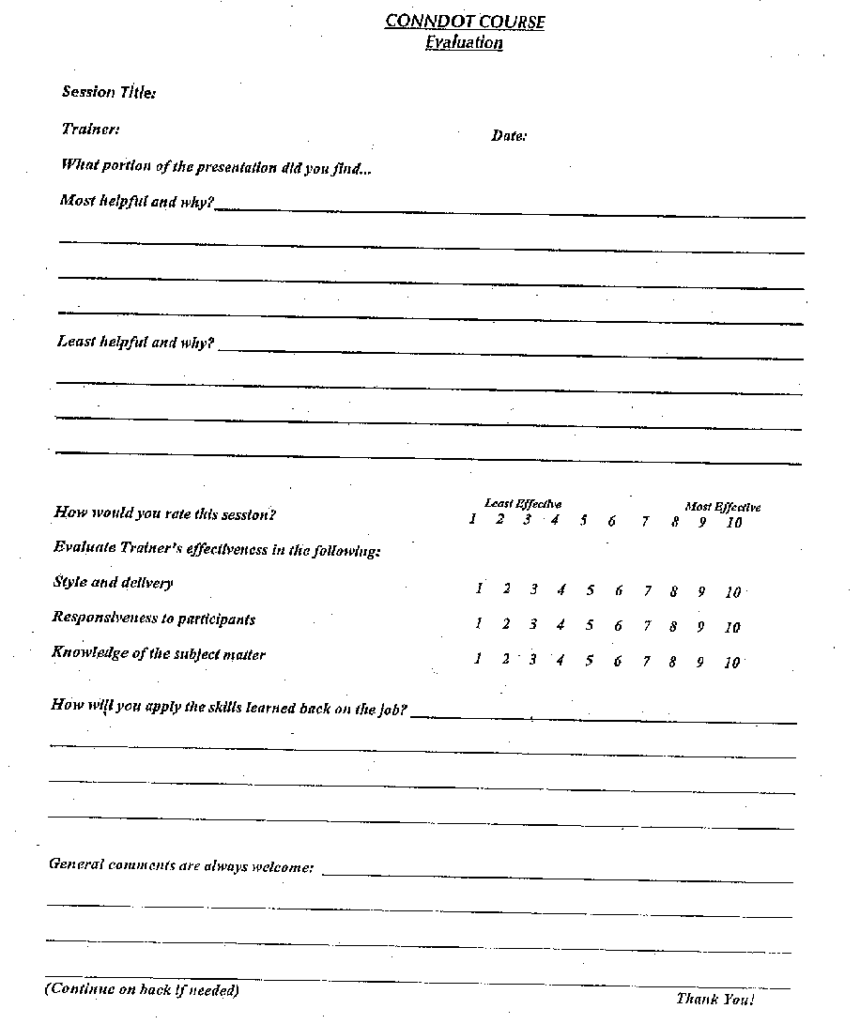
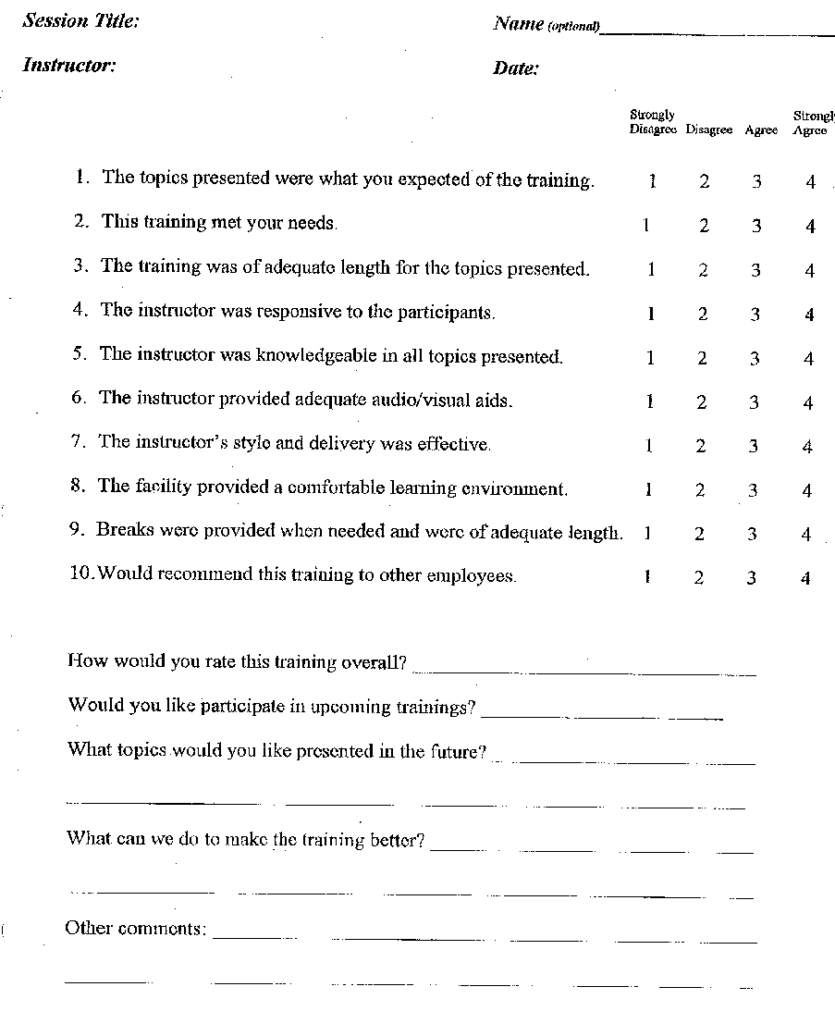

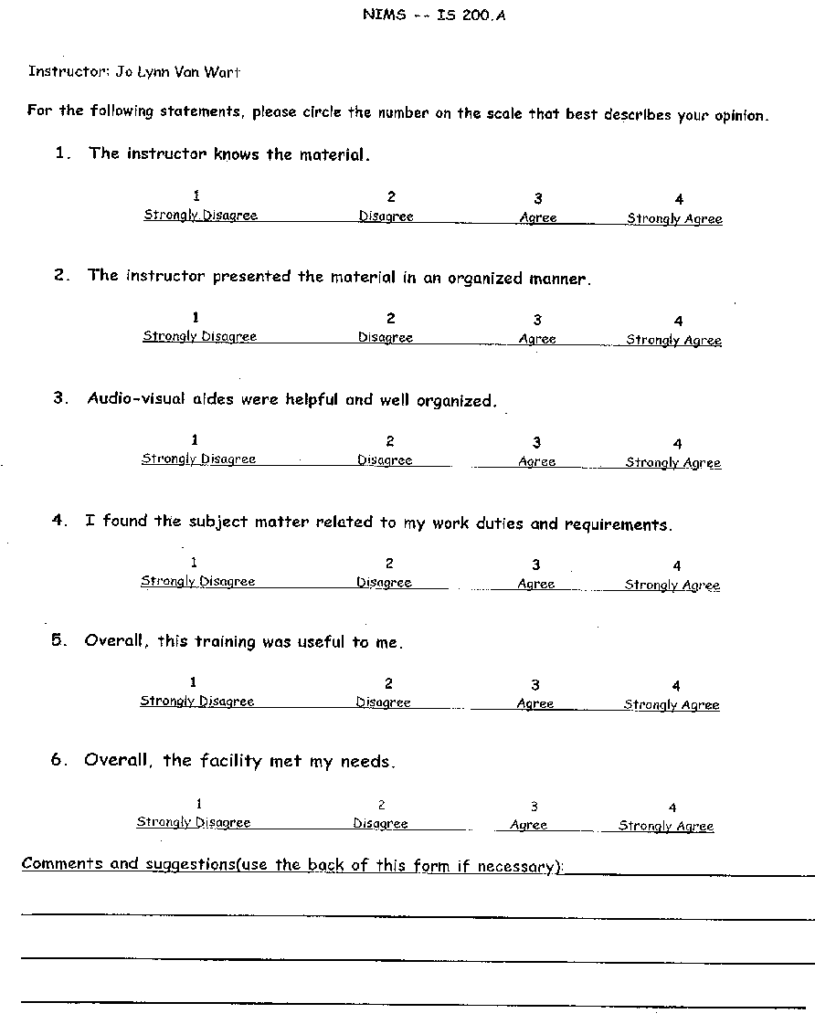
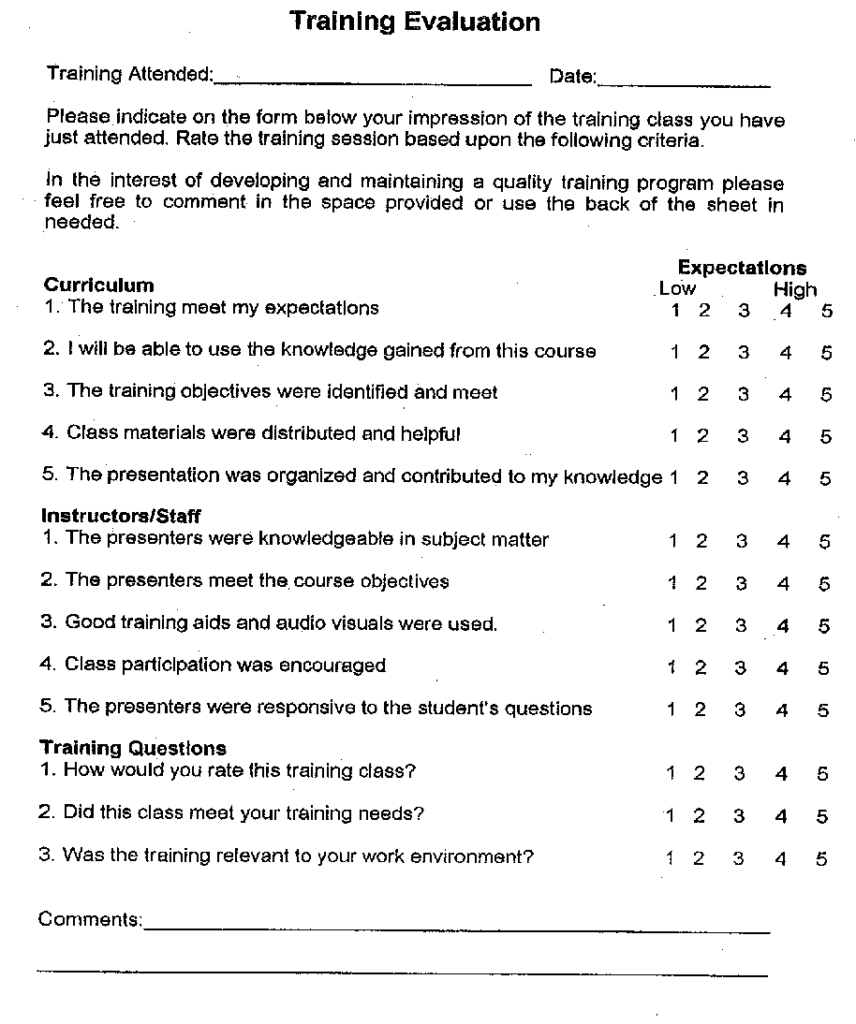
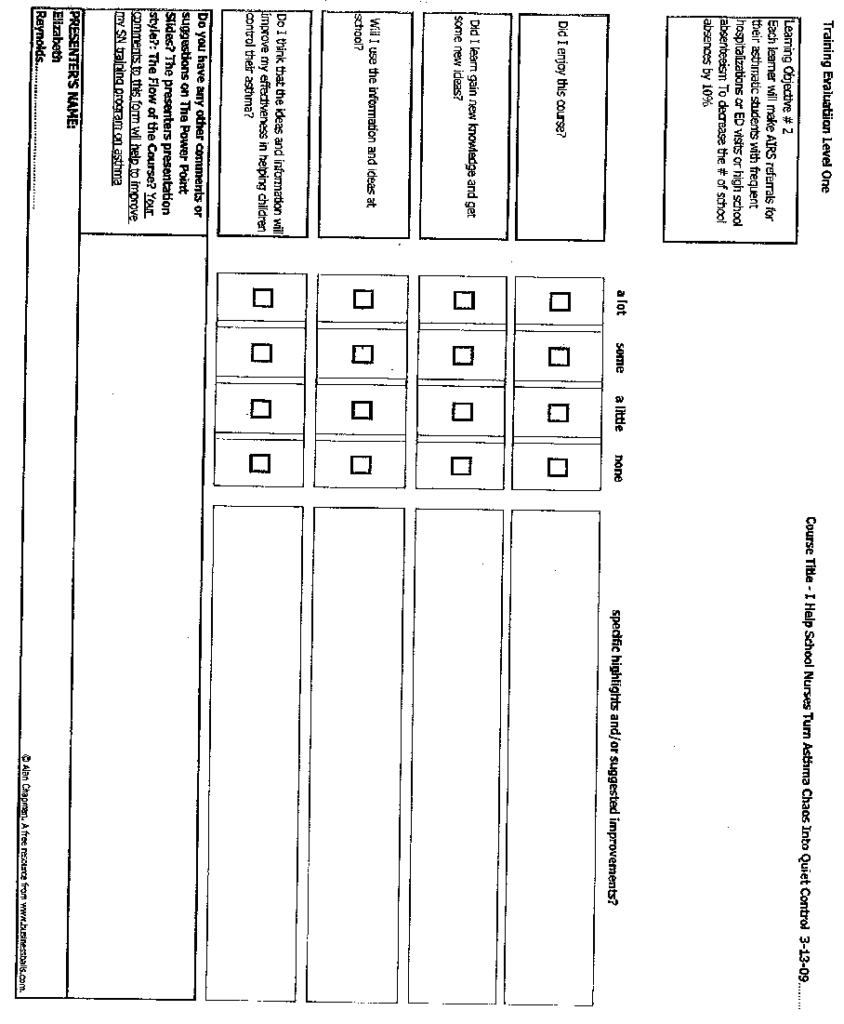
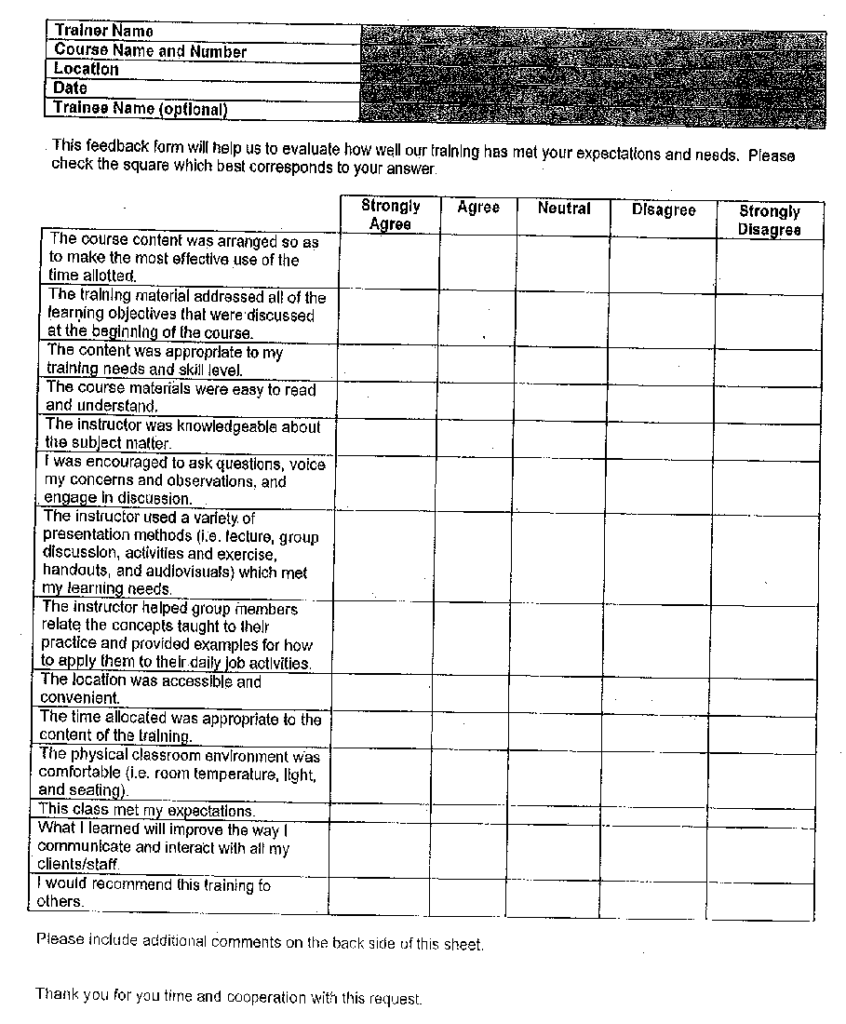
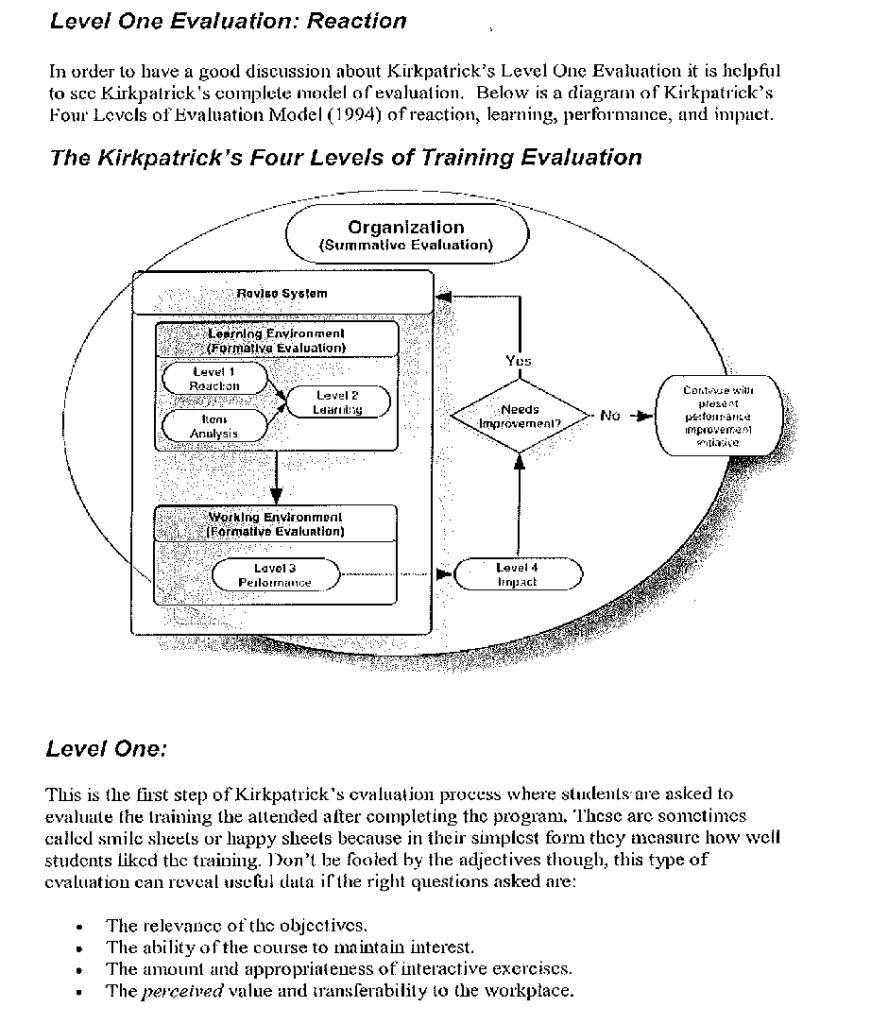

There are those who dislike the Level One Evaluation and scoff at its results being scientific and controlled. Some suggest that just one question need be answered: “Would you recommend this course to a friend or colleague? Why or why not?”
Every training intervention needs some kind of feedback loop, to make sure that within the context of the learning objectives it is relevant, appropriately designed, and competently executed.
At Level I the intention is not to measure if, or to what extent, learning took place (that’s Level 2); nor is it intended to examine the learner’s ability to transfer the skills or knowledge from the classroom to the workplace (Level 3); nor does it attempt to judge the ultimate impact of the learning on the business (LeveI4). Level I of Kirkpatrick’s model is intended simply to gauge learner satisfaction.
The concern or disdain of the Level One Evaluation in many cases comes from poorly designed evaluations that may “steer” respondents. Too many close ended questions without room for comment limit attendee’s comments. The type of questions asked can limit the areas the student is “allowed” to evaluate. Open ended questions while tedious may provide fuller feedback,
Trainers also need to understand that sound analytical evaluations often require multistage studies. Your end-of-course feedback may indicate a problem area, but will not tell you specifically what the problem is. A follow-up survey, by questionnaire, by informal conversation, or by holding a brief focus group, will tell you a great deal more than you could possibly find out under end-of-course conditions.
The level one evaluation none-the-less is an important first step. We need to remember the word level one does indeed imply there are more levels of evaluation. These successive evaluations will help dig deeper into the training experience and assist with identifying that your training programs helped move the organization toward realizing business outcomes. Understanding the objectives/outcomes of any training goal prior to class design will always be the key measure of a successful training program. Without precise and clear objectives the ultimate success of a training program cannot be measured.
The good news about the level one evaluation is that learners are keenly aware of what they need to know to accomplish a task. If the training program fails to satisfy their needs, a thoughtful evaluation will allow the opportunity to determine whether it’s the fault of the program design or delivery.
References:
- Brown, Frederick G. (1971). Measurement and Evaluation. Itasca, Illinois: F.E. Peacock.
- Gilbcrt,T.(1998). A Leisurely Look at Worthy Performance. The 1998 ASTD Training and Performance Yearbook. Woods, J.& Gortada, J. (editors). New York McGraw-Hill.
- Hayes, M. (2003, Feb 3). Just Who’s Talking ROJ? Information Week. p. 18.
- Kelly, T. L. (1939). The Selection of Upper and Lower Groups for the Validation of Test Items. Journal of Educational Psychology. Vol. 30, p.p. 17-24
- Kirkpatrick, DOnald, (1994). Evaluating Training Programs. San Francisco, CA: Berrett-Koehler Publishers, Inc. (NOTE: Donald L. Kirkpatrick is a HRD Hall of Fame member.)
- Markus, H. & Ruvulo, A. (1990). “Possible selves. Personalized representations of goals.” Goal Concepts in Psychology. Pervin, L. (Editor). Hillsdale, NJ: Lawrence Erlbaum, Pp. 211-241.
- Tovey, Michael (1997). Training in Australia. Sydney: Prentice Hall Australia.
- Kruse, Kevin, Evaluating e-Learning: Introduction to the Kirkpatrick Model
- Parkin, Godfrey, marketer, consultant, trainer, conference speaker, Revisiting Kirkpatrick’s Level One
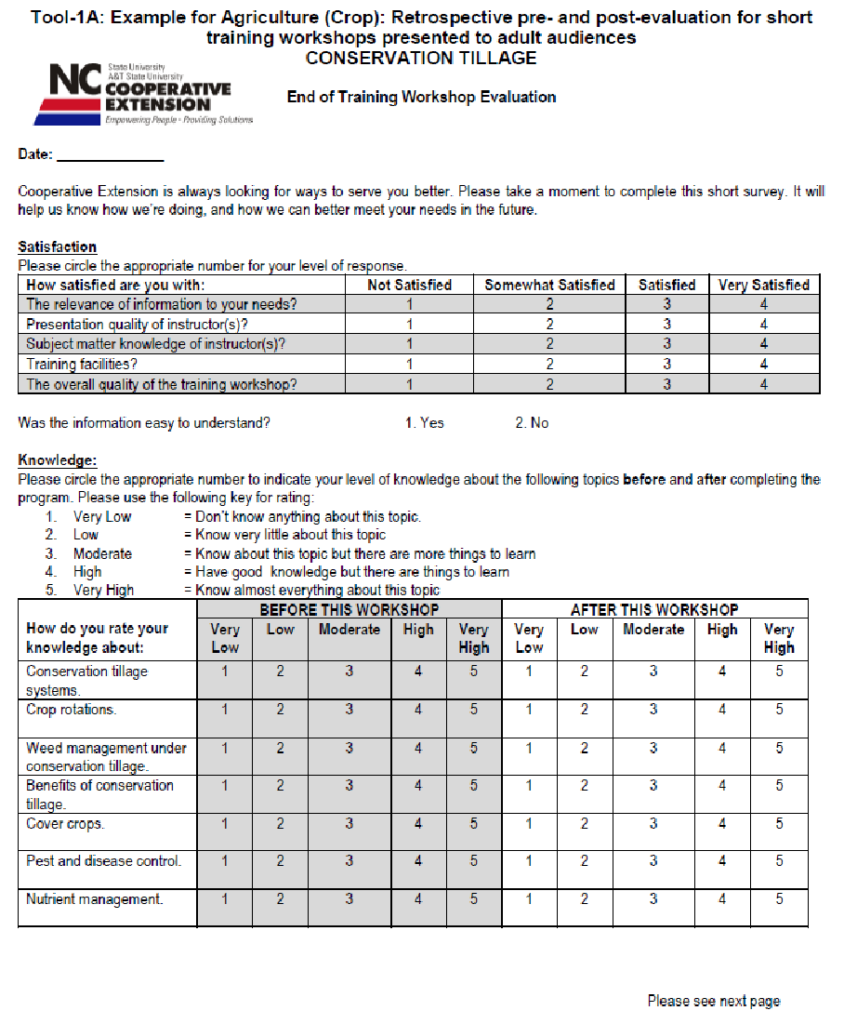

ADDITIONAL RESOURCES FOR TRAINING TOOLKITS INCLUDE:
- The Universities of Washington and California Training Toolkit: : (http://www.go2itech.org/HTML/TT06/toolkit/about/about.html)
- The Sex Abuse Treatment Center: (http://satchawaii.com/resources/child-sexual-abuse-prevention-toolkit/)
- The Substance Abuse and Mental Health Services Administration Focus on Prevention: (https://store.samhsa.gov/product/Focus-on-Prevention/sma10-4120)
1 Finkelhor, D., & Dziuba-Leatherman, J. (1995). Victimization prevention programs: A national survey of children’s exposure and reactions. Child Abuse & Neglect, 19, 129-139.
2 Casper, R. Characteristics of Children Who Experience Positive or Negative Reactions to a Sexual Abuse Prevention Program (1999) Journal of Child Sexual Abuse Vol. 7, Iss. 4,1999.
- Acknowledgements
- Executive Summary
- Introduction
- How to Read This Report
- Mission & Purpose of Taskforce
- A Brief History of How the Taskforce Was Organized
- The Charge of the Legislative Language
- Key Sections
- Section 1: Developing Policies and Procedures for Child Protection
- Section 2: Screening and Background Checks for Selecting Employees and Volunteers
- Section 3: Code of Conduct and Monitoring
- Section 4: Ensuring Safe Physical Environments and Safe Technology
- Section 5: Recognizing, Responding to, and Reporting Allegations and Suspicions of Child Sexual Abuse
- Section 6: Training About Child Sexual Abuse Prevention
- Additional Considerations
- Applying the Framework: A Five-Year Plan
- Appendices
- Section-Specific Appendices
- Downloadable Resources
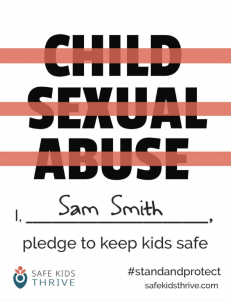
Take the Pledge to Keep Kids Safe
Join us and commit to learning how you can protect the children you serve.
Sign Up to Access Your Learning Center
Customized child sexual abuse prevention guidelines to meet the unique needs of any organization that serves children.
- Evidence-informed guidance
- Actionable prevention steps
- Keeps track of your progress
- Tailored learning tracks


